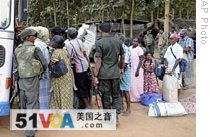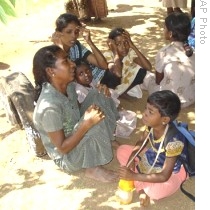Colombo
14 February 2009
 |
| Sri Lankans who escaped from Tamil Tiger controlled areas wait to board a bus in government controlled area at Vishwamadu, 07 Feb 2009 |
Sri Lanka's government has sealed off the relief camps in the country's north to most visitors, including foreign journalists. But eyewitnesses said they are becoming overcrowded and that they lack supplies of drinkable water.
Not true, said Mahinda Samarasinghe, Sri Lanka's minister of disaster management, the government agency in charge of the camps.
Samarasinghe dismissed media reports that a humanitarian crisis was looming. In a heated moment, he berated at least one foreign journalist at a recent press conference for his story in a British newspaper that suggested the relief camps were similar to concentration camps.
"Sri Lanka was accused yesterday of planning concentration camps to hold 200,000 ethnic Tamil refugees from its northeastern conflict zone for up to three years. These types of people, when they write these kinds of articles, should be made accountable," he said.
He added that Sri Lanka's government is working with the United Nations and several nongovernmental agencies to make sure the relief camps have enough food, clean water, medicine, mosquito nets and toiletries.
 |
| Sri Lankan ethnic Tamils grieve after identifying bodies of relatives who were killed while fleeing the Tamil Tiger controlled territory in Vishwamadu, Sri Lanka, 12 Feb 2009 |
That is a big discrepancy in numbers. So how many people are they preparing for? Again, Mr. Samarasinghe:
"We are looking to ensure that we can receive up to 150,000 people. We will be working on the high side because that is the principle when working on disaster management," he said.
For many, just getting to a relief camp has its own risks. At least one woman was killed and at least 13 others were wounded in a pre-dawn grenade attack on a bus carrying civilians out the war zone on Saturday, Sri Lanka's defense ministry said.
Sri Lanka's military blamed the attack on the Liberation Tigers of Tamil Eelam, which it said is trying to prevent civilians from seeking shelter in government-controlled areas - a charge the Tamil Tigers deny.